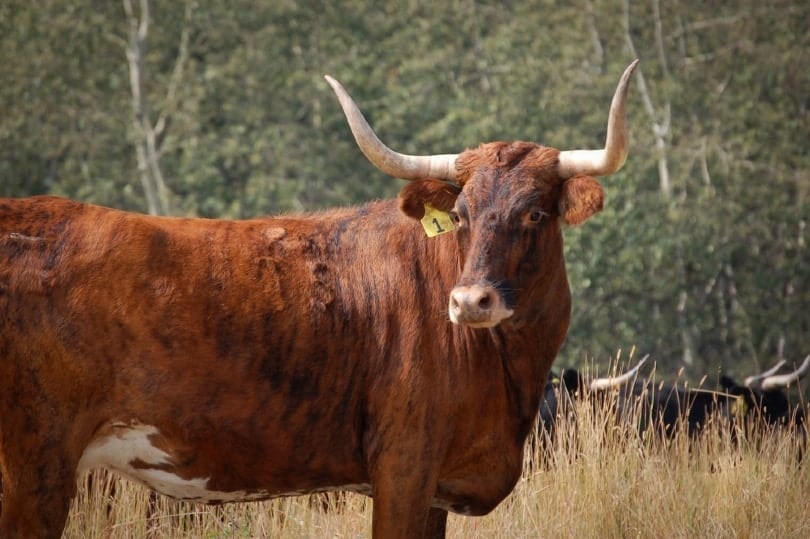Corriente cattle are the descendants of Spanish cattle dating back to the 15th century that were imported into the US. A small but athletic breed, the Corriente is most commonly used in rodeos and is sometimes raised for its beef. This breed has a reputation for being hardy and easy to raise, making it a popular choice for farmers and ranchers.

Quick Facts about Corriente Cattle

| Breed Name: | Corriente/Criolla |
| Place of Origin: | Spain |
| Uses: | Sports, beef, milk, draught |
| Bull (Male) Size: | Up to 1,000 lbs |
| Cow (Female) Size: | Up to 800 lbs |
| Color: | Various, except for solid white |
| Lifespan: | 15–20 years |
| Climate Tolerance: | Native climates |
| Care Level: | Low |
| Production: | Meat, milk |
Corriente Cattle Origins
In the late fifteenth century, Spanish settlers brought the Corriente’s ancestors to the Americas—more specifically, south Florida, the West Indies, plus south and central America. The breed quickly adapted to its new environment, and to this day maintains its reputation as a hardy, independent breed.
The Corriente cattle’s ancestors almost died out due to the importation of new breeds to the Americas in the 19th century, but a few managed to survive in both south and central America.

Corriente Cattle Characteristics
This breed is a fantastic survivor with low-maintenance needs and high enough intelligence to have gained itself a reputation as an escape artist. Corriente cattle can survive out in the open without having to consume much water. They also don’t require as much food as some other cattle breeds and aren’t picky eaters. Both males and females have large horns.
Corriente cattle also have strength and stamina in abundance, and it’s not uncommon to see them taking part in Rodeos. Events Corrientes can be seen in include bulldogging (also known as “steer wrestling” and team roping).
Corriente cows are famed for being easy calvers—they’re solitary birthers and don’t need a human helping hand. This is one of the factors that makes Corriente cows so popular with breeders—no need to bring out a calf puller or keep a special eye on proceedings.
They’re also smart, with a somewhat annoying penchant for escape attempts. Corriente cattle can scale a fence with ease and negotiate their way through some pretty small spaces without much hassle. On the other hand, they’re generally non-aggressive and easy-going unless they or their calves are threatened.

Uses
Corriente cattle are usually used in sports and are sometimes raised for beef. Breeders appreciate how independent and low-maintenance Corrientes are, and particularly their sporting abilities. As mentioned, Corriente cattle are proficient jumpers and are also very strong, which is why they’re targeted for team roping and bulldogging events in particular.
Appearance & Varieties
Corriente cattle have large horns that begin straight to the side and then curve up towards the sky. They can vary in color, but are usually black, red, or chestnut, and are never solid white—though they can have white patches or spots.
A small breed compared to many others, Corriente males can weigh up to 1,000 pounds, whereas females weigh slightly less at around 800 pounds. They have a thick coat, heavy tail switch, a large head, and a narrow, somewhat slender-looking, non-bulky body type.
Population/Distribution/Habitat
Corriente cattle are usually kept in paddocks, on pastures, and open ranges. The exact population is unknown, but this is not a threatened breed and breeding is fairly common. In terms of distribution, the Corriente can mostly be found in the US but is growing in popularity around the world and picking up interest with cattle associations in both the U.S. and Spain.

Are Corriente Cattle Good for Small-Scale Farming?
Corriente cattle are reputed to be good for small-scale farming due to their independence and how low-maintenance they are. They are said to produce milk and beef that’s low in cholesterol and fat as a result of their down-to-earth lifestyles. High-quality grains and greens are what the Corriente needs to thrive.
In addition to this, many farmers and ranchers enjoy raising Corriente cattle for their mild temperaments and for being fairly easy to tame. That said, a level of vigilance is required—with those long horns and the cow’s fierce maternal instinct, Corriente cattle are not a breed you want to mess with!
Related cattle reads:
Featured Image Credit: Anjela Lee, Shutterstock
